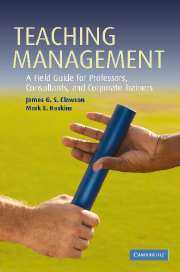Book contents
- Frontmatter
- Contents
- List of figures
- Sources to chapter quotations
- Why this book on teaching management?
- 1 Fundamental elements in teaching
- 2 Levels of learning: one, two, and three
- 3 Adult learning theory: it matters
- 4 Planning a course: trips and tips
- 5 Planning a class: no detail is too small
- 6 Lecturing: the possibilities and the perils
- 7 Managing discussions
- 8 Case method: fostering multidimensional learning
- 9 Role-playing
- 10 Case writing: crafting a vehicle of interest and impact
- 11 Case teaching notes: getting from here to there
- 12 Action learning
- 13 Experiential methods
- 14 Enhancing the conversation: audiovisual tools and techniques
- 15 Executive education: contributing to organizational competitive advantage
- 16 Using technology to teach management
- 17 Counseling students
- 18 Evaluating students: the twin tasks of certification and development
- 19 Teaching evaluations: feedback that can help and hurt
- 20 Research presentations
- 21 Managing a degree program: behind the ‘glory’
- 22 Managing a nondegree client program: an overview
- 23 Dealing with the press
- 24 Managing yourself and your time
- 25 Using teaching portfolios and course portfolios
- 26 Conclusion: is this on the exam?
- Index
Why this book on teaching management?
Published online by Cambridge University Press: 25 February 2010
- Frontmatter
- Contents
- List of figures
- Sources to chapter quotations
- Why this book on teaching management?
- 1 Fundamental elements in teaching
- 2 Levels of learning: one, two, and three
- 3 Adult learning theory: it matters
- 4 Planning a course: trips and tips
- 5 Planning a class: no detail is too small
- 6 Lecturing: the possibilities and the perils
- 7 Managing discussions
- 8 Case method: fostering multidimensional learning
- 9 Role-playing
- 10 Case writing: crafting a vehicle of interest and impact
- 11 Case teaching notes: getting from here to there
- 12 Action learning
- 13 Experiential methods
- 14 Enhancing the conversation: audiovisual tools and techniques
- 15 Executive education: contributing to organizational competitive advantage
- 16 Using technology to teach management
- 17 Counseling students
- 18 Evaluating students: the twin tasks of certification and development
- 19 Teaching evaluations: feedback that can help and hurt
- 20 Research presentations
- 21 Managing a degree program: behind the ‘glory’
- 22 Managing a nondegree client program: an overview
- 23 Dealing with the press
- 24 Managing yourself and your time
- 25 Using teaching portfolios and course portfolios
- 26 Conclusion: is this on the exam?
- Index
Summary
I (Jim) remember my first calculus course. It was at a school recognized by many as one of the top two or three schools in the world. The instructor was a graduate student, a gentleman working on his Ph.D. in mathematics. He was a nice enough man, soft-spoken and relatively congenial before and after class. He even seemed mildly interested in the various nonmathematical events happening around him – Watergate, Vietnam, and the pollution of the environment. Yet when class began, he turned into a creature from another planet: he turned his back on the class and began lecturing (speaking into the board rather), bouncing his words off the board in a spray pattern that drifted over us and settled ever so lightly on our young heads. He wrote fast, and we wrote fast. Sometimes we'd stop writing and raise our hands, but the instructor, his eyes somewhat glazed over by the beauty of the equations and mathematical connections he was painting, often did not see us, or ignored us, and continued until his cognitive cantata was completely composed and the final chord sounded. Then, holding the chalk lightly like a baton between his thumb and index finger, and characteristically giving an ebullient wave of his writing hand, he would turn and face us with a thin, satiated smile and ask, “Any questions?” the true meaning of which was, “True mathematicians (musicians) will have understood and felt the beauty of this development and will appreciate its elegance. Let's not disrupt the effect of the whole by dissecting its parts for the less-educated or -sophisticated”.
- Type
- Chapter
- Information
- Teaching ManagementA Field Guide for Professors, Consultants, and Corporate Trainers, pp. 1 - 11Publisher: Cambridge University PressPrint publication year: 2006



